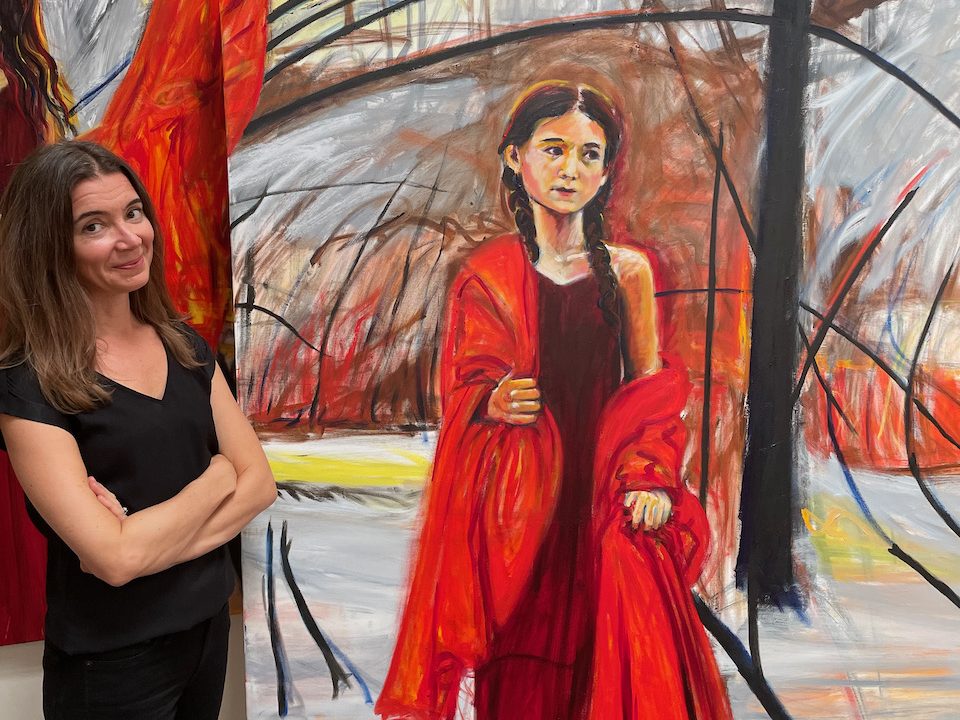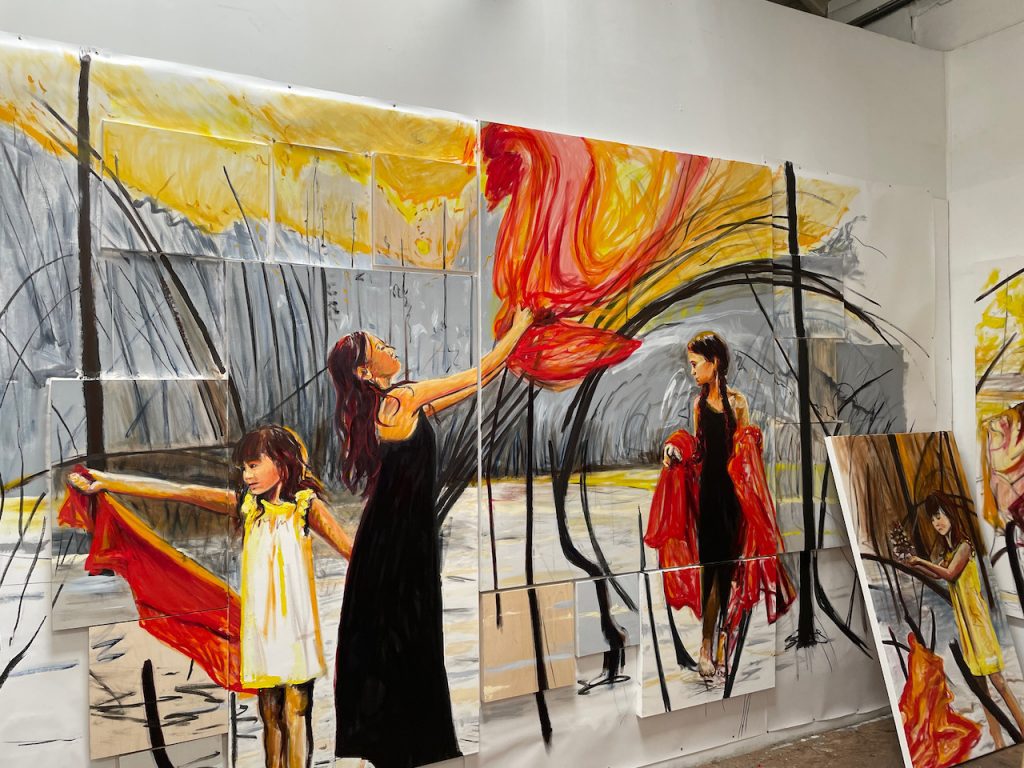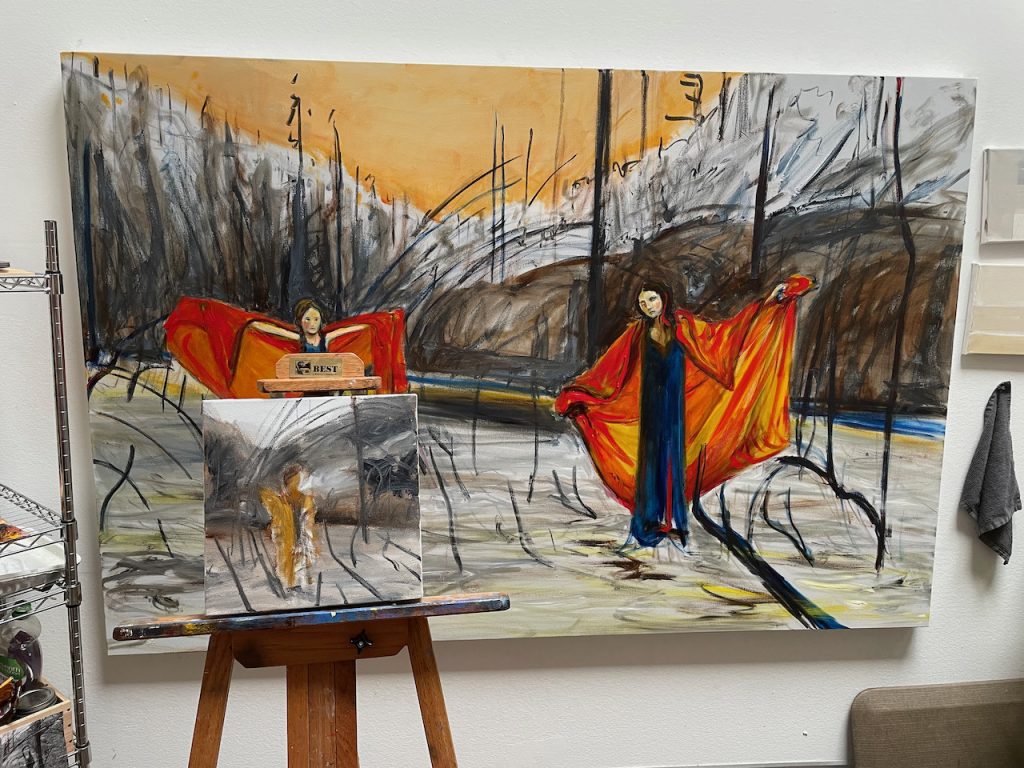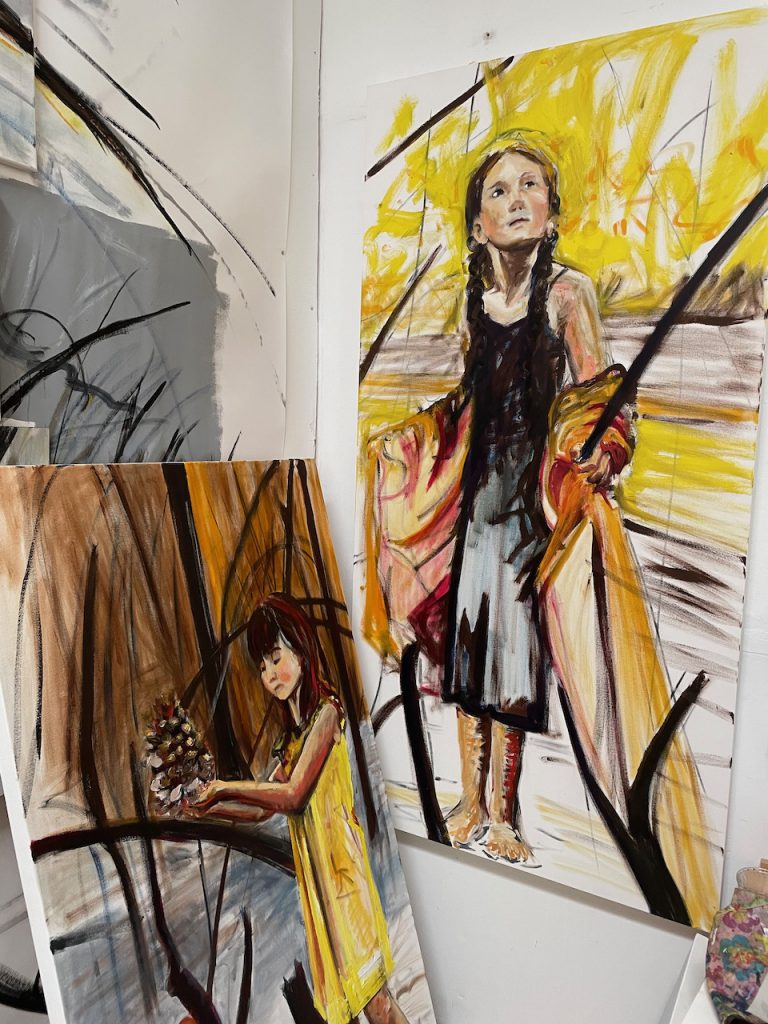
I chatted with Christine in her luminous West Oakland studio in late September, as she prepared for her first Gearbox feature exhibition Unlikely Heroes, with sculptor Samuelle Richardson. Since meeting Christine a few years ago, I’ve been fascinated by the way she is able to balance her studio practice, being a parent, home school educator, curator and member artist at Gearbox. Perhaps what’s most interesting is that she’s found a way to make all of these roles complement each other, rather than fight for her attention and energy. Passing on some wisdom she once received from another artist adapting to life as a parent, Ferrouge shared “rather than designing a life around your children, invite them into your life.”
That close, authentic integration between art-making and family has been front and center in Ferrouge’s work for the last several years. Using her daughters as models, she explores the role that imagination plays in child development, and how it helps us envision our future selves. In their larger-than-life scale, the girls in Ferrouge’s paintings have more agency than models sitting for a portrait, but they feel like integral characters in a grand allegory.

In this new body of work, Ferrouge has invited her daughters on an adventure to explore the scarred landscapes that have become all too familiar in California. As in previous work, her daughters figure prominently in the composition but now are leading the viewer into a mysterious narrative where we journey through ghostly remnants of a forest. There’s a sadness to the forest that Ferrouge has captured; the grayness and bareness permeates everything. The branches in their singed-black hue act as visual conduits through the space in a way that is both vicious and lyrical. In the sparsely painted ground plane–the bits of neutral color flicker next to the white of the open canvas and imply that the ground is blanketed with ash. In contrast to the stark and injured forest, Ferrouge’s daughters bring a sense of play and curiosity as they explore their eerie surroundings.
Below is an excerpt of our conversation. My questions are in bold text.
In the context of your ongoing investigation of girlhood and the formation of identity, how does the work for Unlikely Heroes fit into your larger project?
Part of growing up is learning how to survive whatever parameters the world throws at you. It could be social culture (like I studied in my princess and dress up series), it could be invisible threats (like I studied in the Picnic series) or in this case it could be forest fires.
The forest fire is about actual questions about how will we survive if so much of the earth’s trees burn away, but it is also a symbolic picture of surviving any disaster in one’s life. So far these girls are safe and have had a life with normal kid challenges, but one day they will experience disaster in their lives. Will they have what it takes to survive it?
Imagination play is how we practice preparing for that moment.

How has your work evolved in this new series?
I started working on the first 6 x 8 foot painting for this series at my Werkshack studio in uptown. Quickly I began to feel exceptionally cramped because it is about forest and life size figures. Scale is critical. Right around that time, I was given the slot in the GearBox schedule for this October show. And I received a call from my former studio manager who knew I had mentioned I was interested in extra space. I took the space and I was very fortunate to expand into a second studio in my old building on 26th and Magnolia. There I have been able to let the paintings speak to each other and create a true body of work all at once.
It means that the color and texture have cohesive threads throughout the work, and together the paintings are each speaking about different aspects in the exploration of the girls in the damaged forest.
Thinking about the transformation from your source photos to the painted image, what were some of your creative strategies? How do your paintings distinguish themselves from their source material?
The photographs we took for this body of work are amazing. But there is something that happens when you translate an image into paint. Gestures and expressions shift. Scale and emphasis changes. The surface is activated. There are abstract marks that say things that the source photography can’t.
As a fellow painter, I’m often fascinated by how painters decide what to render in a very specific way, and what to leave more open and gestural. How do you navigate the spectrum between specific and general in your work? How do you decide what to leave open and gestural?
The source material is a source. And abstraction is a natural thing that happens. Abstraction is what always happens when anyone makes art, but to varying degrees. For me, i start with a classic underpainting approach of browns and yellows, but instead of spreading that across the whole surface I only use the parts that are important. The ‘blank” or untouched parts exist as in a memory or a dream where there simply isn’t anything there so you can focus on what is important.

How did your pairing with sculptor Sameulle Richardson for your upcoming exhibition at Gearbox arise? What drew you to her work?
When I first imagined this show, I immediately thought of Richardson’s dogs. I had seen them in her studio and a show at the Palo Alto art center. Samuelle is a friend of mine through the Kipaipai Workshops fellowship. Eventually I asked her and the rest is history =).
When we discussed it as a possibility, and also as we developed the title of the show, we discovered just how much our content inspiration we have in common. The beings we both create are often the underdogs, or not naturally the ones that people would assume to be strong. Ironically in many situations, they outwit and overcome amazing obstacles in order to survive.
What makes the work in Unlikely Heroes special?
This moment/series is about being on the cusp of these girls beginning to look outward at the world. In general, it is pretty unique that I paint girlhood from first hand observation in a contemporary way. And that the girls are dignified and not like the women in most of art history as sexualized objects and even contemporary images.
Unlikely Heroes: Christine Ferrouge & Samuelle Richardson runs from Ocotober 7 to November 13, 2021.
